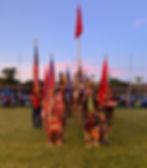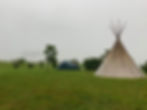top of page

Histories

Star Quilts
For many Native Americans, the star is a sacred symbol, equated with honor. This belief is a respected and longstanding tradition, inherited from their ancestors. The Lakota Sioux Indian nations of Eastern Montana and North and South Dakota had a spiritual belief in the stars, especially in Venus, whose reflected light made it one of the brightest objects in the night sky with the appearance of a star. The planet Venus was their guiding star. It represented the direction from which spirits travel to Earth, symbolizing immortality.
Today, it continues to herald a new beginning, a new day dawning. Standing between darkness and light, the morning star leads to understanding. Star patterns using natural plant dyes adorned hides and TIPIS (teepees). The symbol was interwoven within porcupine quill work and beaded patterns used on moccasins, leggings and clothing. When missionaries came in the mid to late 1800's and introduced fabric and sewing to Native American women, the "Morning Star Quilt" was born. It replaced the traditional red buffalo robe and was displayed at their funerals as a means to honor and protect loved ones on their final journey through the stars. Its tradition of honor grew as the quilts were draped around the shoulders of their braves and hunters when they returned from battle or a successful hunt. Often the young men would wrap themselves in a quilt on their vision quests.
The quilt and its traditions have been adopted by many Indian tribes. And like many other Native American cultures, they believe it is more of an honor to give rather than receive and still use the quilt today in their “give-away” ceremonies. The quilt is now more simply called “Star Quilt”. Today, Star Quilts are one of the most valued gifts of the Northern Plains Indians. They are seen as banners of Honor and Respect,they are often used as altar cloths in churches, placed on top of sweat lodges and used in powwows. They may be given to honor a special friend or family member, to a newly married couple, or to parents in celebration of a child’s birth. They are given in sympathy to a family, honoring a loved one who has died. They are even given to those whom they have never met, out of respect, honor and admiration.
Star Quilts are still wrapped around the shoulders of the recipient as a symbolic way to honor and protect that person on their journey through life. Giving is a universal tradition. Like the makers of the original Star Quilts who bestow their treasured creations upon others, rather than keeping them all of us have a capacity to share. When you see the image of the Star Quilt, let it be a reminder that there is honor in giving.



1/1
Pine Ridge Indian Reservation
The Pine Ridge Indian Reservation (Lakota: Wazí Aháŋhaŋ Oyáŋke), also called Pine Ridge Agency, is located in the southwest corner of the U.S. state of South Dakota. Originally included within the territory of the Great Sioux Reservation, Pine Ridge was created by the Act of March 2, 1889, Today it consists of 3,468.85 sq miles of land area and is one of the largest reservations in the United States, larger than Delaware and Rhode Island combined.
The reservation encompasses the entirety of Oglala Lakota County and Bennett County, the southern half of Jackson County. Of the 3,142 counties in the United States, these are among the poorest. Only 84,000 acres of land are suitable for agriculture.
Pine Ridge is the site of several events that mark milestones in the history between the Sioux of the area and the United States (U.S.) government. Stronghold Table—a mesa in what is today the Oglala-administered portion of Badlands National Park—was the location of the last of the Ghost Dances. The U.S. authorities' attempt to repress this movement eventually led to the Wounded Knee Massacre on December 29, 1890. A mixed band of Miniconjou Lakota and Hunkpapa Sioux, led by Chief Spotted Elk, sought sanctuary at Pine Ridge after fleeing the Standing Rock Agency, where Sitting Bull had been killed during efforts to arrest him. The families were intercepted by a heavily armed detachment of the Seventh Cavalry, which attacked them, killing many women and children as well as warriors. This was the last large engagement between U.S. forces and Native Americans and marked the end of the western frontier.
Changes accumulated in the last quarter of the 20th century; in 1971 the Oglala Sioux Tribe (OST) started Oglala Lakota College, a tribal college, which offers 4-year degrees. In 1973 decades of discontent at the Pine Ridge Reservation resulted in a grassroots protest that escalated into the Wounded Knee Incident, gaining national attention. Members of the Oglala Lakota, the American Indian Movement (AIM) and supporters occupied the town in defiance of federal and state law enforcement in a protest that turned into an armed standoff lasting 71 days. This event inspired American Indians across the country and gradually led to changes at the reservation, with a revival of some cultural traditions.
Source: https://en.wikipedia.org/wiki/Pine_Ridge_Indian_Reservation
bottom of page


